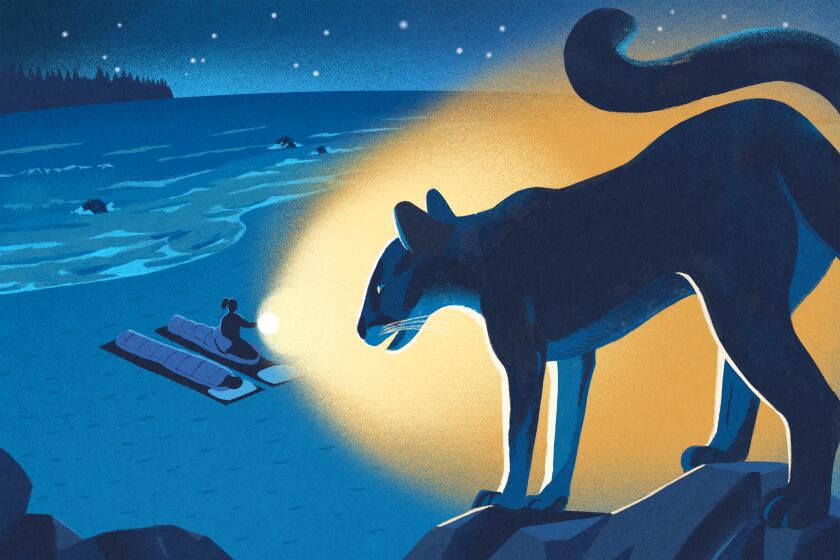Volunteer Groups Give Horses Safe Home on the Range
In a remote corner of the Antelope Valley, more than 300 horses gambol on a 40-acre desert ranch. But if it weren’t for Linda Moss and her army of volunteers, the horses would have met an entirely different fate--in the slaughterhouse.
“We have a little miracle going up there,” said Moss, who runs a Glendale-based group called Equus Sanctuary. “We feed 3 tons of hay a day.”
Indeed, the Antelope Valley ranch--whose location is a carefully guarded secret--costs more than $30,000 a month to maintain and may be the largest preserve of its kind in the country.
It had its beginnings 10 years ago, when Moss attended an auction of Arabian horses in Pomona. Moss, who loves the breed, was shocked to see meat buyers snap up 38 of the 112 animals.
At that time, the market for horses was glutted. Before federal tax reform in 1986, horse breeding offered a myriad of tax advantages to investors. Others were drawn by skyrocketing prices for top horses.
But the breeding business took a cold shower after tax reform. While many legitimate breeders welcomed the change, others suddenly found themselves with a glut of horses, unable to find buyers. The meat dealers stepped in, gobbling up horses at auctions, at dispersal sales and from backyards, promising good homes but often turning a quick $50 profit per horse by acting as middlemen for slaughterhouses.
“It was largely very wealthy people who dumped their horses all at once,” said Moss, who gave up her career as a motion picture sound editor to form Equus Sanctuary. “It was just a blood bath.”
Almost 3 million horses--2,944,004, to be exact--died from a 4-inch bolt to the head at a handful of U.S. slaughterhouses over the last 15 years, according to the U.S. Department of Agriculture. Countless others met similar fates, jammed aboard double-decker cattle trucks bound for Canada and Mexico.
Contrary to popular belief, horses sent to the “glue factory” are not just the old, the blind and the crippled. California law, in fact, prohibits shipping any horse not sound enough to stand on all four feet. Rather, slaughter horses run the gamut from foals, prized for their veal-like tender meat, to former show horses and racing champions.
That sends a shudder through horse lovers seeking a new home for an equine friend.
Slaughter of Horses Banned
Growing concerns about horse butchery led to an initiative measure, which was approved by California voters last fall, banning the sale of horses for slaughter.
“You couldn’t find an inexpensive horse for the kids or just to ride down the trail. They had all been killed,” said Cathleen Doyle of the California Equine Council of Studio City, which pushed the initiative. “Every horse that sold for less than $1,000 was in jeopardy.”
The meat buyers “really raped our economy of our horses,” said Gini Richardson, legislative chairwoman of the California State Horsemen’s Assn.
Slaughterhouses declined comment for this article.
Although the California law, the first of its kind in the nation, now makes the sale of a horse for slaughter a felony, equine advocates say it has not been fully effective.
“You don’t see the double-deckers on Tuesdays shipping horses out by the hundreds any more,” Richardson said. “But you do see them moving out by the onesies, twosies and tensies” and showing up in low-end auctions in Arizona and elsewhere.
*
Doyle and others are now turning their sights on other states, unabashedly intent on putting the five equine slaughterhouses remaining in the U.S. out of business.
Along with it, they want to quash the appetite for horse meat in Belgium, France, Italy, Mexico and Japan, where it is so cherished. Foreign consumers happily fork over $15 a pound for the slightly sweet-tasting, marbleized delicacy of horse meat.
Never matter that horses, unlike livestock, usually are loaded with phenylbutazone, or bute, an anti-inflammatory drug, or dewormers that contain the warning: “Do not use in horses intended for food purposes.”
Eating horse meat--or buying it from a slaughterhouse--is perfectly legal in the United States, according to Elizabeth Gaston, a spokeswoman for the USDA.
But as a practical matter, there is no domestic market. Instead, the over-breeding of horses supplied a ready demand for meat in foreign markets.
From 1987 through 1992--the years immediately after tax reforms--between 200,000 and 300,000 horses annually were slaughtered in the U.S.
Yet, in just the last two years, the number of horses slaughtered has plummeted to fewer than 100,000 annually. Richardson said that is solely due to dwindling supply.
California, and particularly Southern California, is the horse capital of the world. Although it is second to Texas in its horse population (642,000 versus 687,000), the California horse economy leads the nation at $11.4 billion annually because more horses here are boarded and because the cost of keeping and maintaining horses is higher here, according to the American Horse Council.
Horse rescue operations are diversified and sometimes controversial, often with rescuers critical of one another. But most agree that their motivations are the same: to save the horses.
Moss of Equus Sanctuary and her colleagues look for horses in feedlots--which are kind of like used car lots for horses. This is where most of the unwanted horses end up.
Horses Supported by Donations
Lot owners sometimes retrain the horses and sell them to good homes, but the hard cases often get shipped out of state to an uncertain future.
Moss buys Arabians mostly, but also other breeds, ponies and burros that are too wild, crippled, blind or small to ever find a home. The horses are retired permanently and supported entirely by donations and teams of volunteers.
In tiny Leesburg, Va., Pat Rogers was 53 and working the night shift in a convenience store in 1990 when she decided to launch the Equine Rescue League.
Her inspiration came from a crippled, 5-year-old thoroughbred mare too lame to stand that was sold to a meat buyer for $7. Rogers said she told the pathetic animal: “I have no place, no money, no way to get you out of here. But, by God, I will do it.”
*
The league now shelters 49 horses at a time on a 66-acre ranch. Adopters are required to sign a five-page contract prohibiting them from ever breeding or reselling a horse.
RoseAnn Nemes of Shadow Hills, near Sunland, was one of Moss’ volunteers at the Equus Sanctuary until she launched her own rescue operation two years ago. Working full time as a manager of a philanthropic fund for a Los Angeles religious order, Nemes is at work by 6:30 a.m. in order to free her afternoons to care for horses.
Called the Arabian Horse Rescue Network--at https://www.ahrn.org--the group is now one of the most successful. Using the Internet almost exclusively, it has placed more than 70 horses nationwide to date.
*
Nemes was inspired by one of the first horses she helped pull out of a feedlot, a 20-something Arabian gelding named Arthur. “I get teary-eyed when I talk about Arthur,” she said, dabbing at moist cheeks. “I knew instantly that Arthur was the horse that I should have had as a little girl,”
She adopted him, and two others and now rescues two or three horses at a time. The rescued animals, often in poor physical shape, are restored to health before they are sent to new homes.
But there is one horse, Nemes says, she will never give up. “No one will ever take my Arthur from me. Not over my dead body.”
More to Read
Sign up for Essential California
The most important California stories and recommendations in your inbox every morning.
You may occasionally receive promotional content from the Los Angeles Times.










